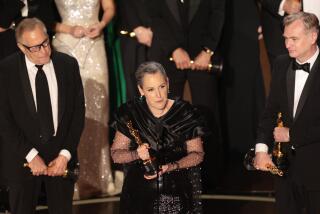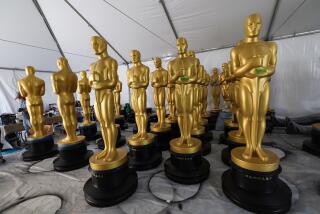On TV, the Oscars are more gray than gold
Sunday’s Academy Awards will feature many of Hollywood’s shiniest stars, including Barbra Streisand, the cast of “The Avengers” and comic Seth MacFarlane. They’ll be celebrating a slate of nine best picture nominees that includes six $100-million blockbusters.
But the celebrities must do more than hand out awards or sing and dance: The Academy of Motion
Picture Arts and Sciences, and longtime broadcaster ABC, need their talent to inject new life into a show whose audience has been declining steadily and aging rapidly.
Oscars 2013: Nominee list | Live ballot | Trivia | Timeline
Once considered an unstoppable phenomenon, the so-called Super Bowl of entertainment has lost momentum. The awards bash drew an average of 46 million viewers in the 1990s, according to Nielsen. Though it’s still the top non-sports TV event, the telecast has attracted 40 million viewers only once in the last five years, in 2010.
What’s more, the median age of the audience has risen from barely 39 two decades ago to nearly 53 last year. That number is worrisome not only to advertisers but also threatens the ceremony’s long-term viability as a must-see TV event.
To expand an audience that is becoming smaller and grayer, the veteran Hollywood producers in charge of this year’s broadcast, Craig Zadan and Neil Meron, are attempting what might be called the something-for-everyone Oscars. This year’s show will feature songs from Streisand and Adele, a sketch based on the movie “Ted” (which MacFarlane directed and wrote), a movie-musical medley and a James Bond tribute.
It’s the first time at the helm for the duo (who have been behind stage-to-screen films such as “Chicago”), but there’s little historical evidence that many of the weapons at their disposal — picking a young host, cooking up a bevy of celebrity-studded special presentations, adding song-and-dance numbers — have a tangible effect on viewership.
Academy President Hawk Koch has said that he wants the broadcast to be “an entertaining show that gives out awards” rather than an awards show with entertainment.
In 2011, producers experimented with young hosts James Franco and Anne Hathaway; the broadcast was widely panned. Last year, the Oscars got back to the tried-and-true with Billy Crystal, then 63, who stepped in after Eddie Murphy dropped out.
MacFarlane, 39, represents a different kind of bet. For the entertainer who created the ribald animated Fox hit “Family Guy,” the challenge is to lure in younger viewers while not turning off the more genteel, traditional Oscar audience.
Oscars 2013: Nominee list | Live ballot | Trivia | Snubs | Reactions | Timeline
“Last year was righting the ship after the James Franco experiment the year before,” said Dave Boone, an Emmy-winning writer who’s worked on eight previous Oscar telecasts, including the 2012 show with Crystal. “This year, producers believe it’s time to try something different.”
Boone said the producers must strike a delicate balance showcasing MacFarlane. “You don’t want to change who he is, but you want to play to the part that’s most accessible,” Boone said. “Because once you lose the room, it’s very hard to get it back.”
MacFarlane is trying to manage expectations. In a televised interview this week, he said that he’s going in at “minus 10,” asserting that his Oscars will be “most astonishingly, dazzlingly mediocre.”
Last year, total viewership for the Oscars was 39.3 million, a nearly 4% uptick from 2011 but still way below those 1990s numbers. (The record, 57 million, was set in 1998, when “Titanic” swept the ceremony.)
Last year’s median audience age of 52.8 was a jump of 2.2 years from 2011, the biggest such increase in a decade.
Play-at-home ballot: Have you made your picks yet?
Conscious of the slide, ABC has been in an all-out promotional blitz. In its popular prime-time comedy block on Wednesday, writers embedded Oscar plotlines in all of its shows, including “Modern Family” and “The Middle.” On “The Middle,” Patricia Heaton’s suburban mom eagerly encouraged her family to sit down on the couch and watch the Oscars after earlier proclaiming it the “Super Bowl of Hollywood.”
Despite the ratings challenges, ABC has raised its price for a 30-second spot this year to about $1.7 million, up from $1.61 million last year, with total revenue expected to reach about $85 million. Last year’s Oscar revenue was about $82 million, a high for the network.
Some pundits have looked to the box-office success of this year’s best picture nominees as a potential ratings savior: Six of the nine nominees grossed at least $100 million, the first time so many have crossed that mark. The median box office of the nine contenders is $109 million — the highest since the best picture field expanded beyond five nominees beginning with the 2010 show.
But there’s little correlation between the median box office for best picture nominees and TV ratings. In 2011, when “The King’s Speech” ruled the evening, the median box office was a solid $101 million. Yet that year had the weakest total viewership since the best picture field expanded — 37.9 million. Higher ratings do seem to result when there’s one or two mega-blockbusters among the nominees. But that isn’t the case this year, as 2012’s three top-grossing pictures — “The Avengers,” “The Dark Knight Rises” and “The Hunger Games” — received just one nomination total. (In 2010, when “Avatar” was nominated, viewership jumped to its highest total in seven years.)
While producers sometimes look to a younger emcee like MacFarlane in hopes of goosing viewership, there’s little evidence they bring a jump in viewers under 35. Four of the five least-watched shows in the last quarter-century were hosted by people 45 or younger. Last year’s host, Crystal, was the oldest since the 1970s. Viewership reached its second-highest level in five years.
Part of the viewership challenges might be traced to a lack of diversity. Minorities make up 35% of the U.S. population, according to
the most recent census, and are concentrated in the lower portion of the age spectrum.
But the academy that votes on the awards is much more monochrome. In a study last year, The Times found that 94% of the academy is white. This year’s best picture nominees include several films with diverse casts like “Django Unchained” and “Beasts of the Southern Wild.” And there are two high-profile black actor nominees — Denzel Washington in the lead actor race from “Flight,” and Quvenzhané Wallis for lead actress from “Beasts.”
Boone said it’s possible to lure new viewers to awards shows with bells and whistles, but if they stray too far off-point — or if MacFarlane’s act begins to feel like it would be better suited to a comedy special — audiences could tune out. “It’s a fine tightrope you have to walk,” he said.
Brian Volk-Weiss, whose New Wave Entertainment is a leading producer of one-hour televised comedy specials, believes MacFarlane will bring fresh energy to the ceremony.
“The issues with hosting the Oscars is that there are a lot of moving parts, so you have to have a lot of comedic improv skills, and he’s hands-down one of the best improvisers I’ve ever seen,” Volk-Weiss said. “And he’s so charming and so funny that the people who don’t know who he is are going to become fans of him before the first commercial break.”
Times staff writers Joe Flint and Meg James contributed to this report.
MORE OSCAR COVERAGE
VOTE: Play-at-Home Oscar Ballot 2013
TIMELINE: Academy Awards through the years
More to Read
From the Oscars to the Emmys.
Get the Envelope newsletter for exclusive awards season coverage, behind-the-scenes stories from the Envelope podcast and columnist Glenn Whipp’s must-read analysis.
You may occasionally receive promotional content from the Los Angeles Times.









